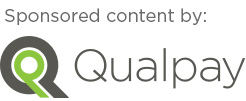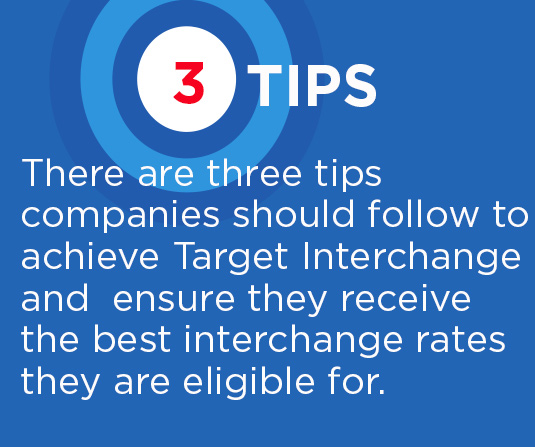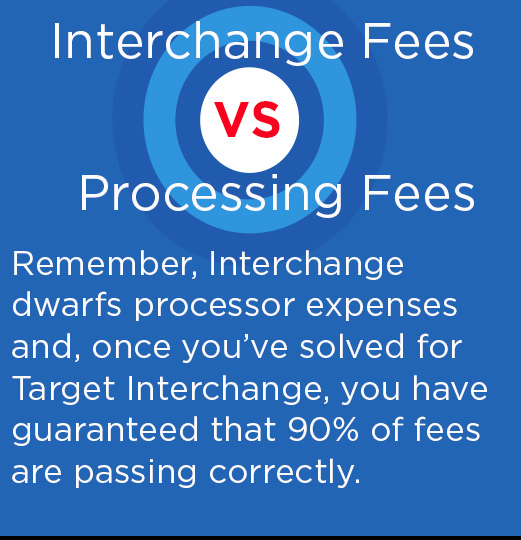 Understand the true cost of accepting payments.
Understand the true cost of accepting payments.
The payment tools most fuel marketers use today were created in the early 2000’s, or even the late 90’s, and have remained relatively unchanged over the years. While payment tools have mostly remained the same, our industry has evolved to accommodate the unique way fuel marketers run their businesses.
Fuel marketers have been able to qualify for utility pricing since 2005, but without access to updated technology marketers will often unknowingly fall out of utility pricing and increase their costs. Making sure marketers are set up correctly with each card brand is only half the battle. Interchange (the cost from the card brands) dwarfs processor expense and accounts for 90% of a fuel marketers bill.
 There are three tips companies should follow to achieve Target Interchange and ensure they receive the best interchange rates they are eligible for.
There are three tips companies should follow to achieve Target Interchange and ensure they receive the best interchange rates they are eligible for.
First, make sure your company is set up correctly with each card brand
In 2005 MasterCard and Discover classified fuel marketers as a Utility and a few years later Visa followed suit and classified fuel marketers as an Emerging Market. This reduced the cost of accepting eligible card types at the card brand level making a large impact on reducing the fees you pay. To qualify for these rates you have to be configured properly as a fuel marketer. Make sure that the company you’re working with can pass both codes (Utility and Emerging) so that you can qualify your transactions at the best rates across all card brands. One thing that most fuel marketers are surprised to find out is that AMEX also offers a “Services” rate. While it is still a little more expensive than the other brands, it’s much cheaper than their standard rate and will lower your fees on AMEX.
Second, make sure you have access to updated payment technology to clear up any downgrades
Each card type your business accepts has a price set by the card brands known as Interchange. There are roughly 30ish Interchange categories that typically affect fuel marketers spread between Visa and MasterCard. Variations in card acceptance, business classification and platforms, result in over 500 potential interchange expense buckets (yup, pretty crazy).
The card brands associate a cost bucket on each payment card that your company accepts. The least expensive rate for each card type is referred to as Target Interchange and is the best possible rate your transactions can qualify for. But as with everything, there’s a catch. To achieve this magical Target Interchange the card brands require that everything is just right. You have to be set up properly, following all card brand rules, with all necessary data (per card type) passing through- whether that be a simple CVV, or more complex data such as tax rate or customer ID. This might seem easy, but with 500 buckets, all requiring different bits of data, updated technology plays a major role.

Photo: Qualpay
Some companies perform really well, however, if the technology your company uses is outdated, you will be unable to pass along certain qualifying criteria with your payment transactions. The most common payment gateways utilized in our industry were created in the early 2000’s and developed for generic business types, not the unique requirements of today’s fuel marketer. Since the data exchange happens at the gateway level if the gateway can not pass the necessary data the card brands place the transaction in a more expensive bucket. When Target Interchange is missed, it is referred to as a downgrade. The result is that fuel marketers end up paying more money than they would if the qualifying data had been passed correctly, in some cases 1.00%.
For instance, outdated technology may not be able to pass a tax ID, which is a data requirement for Target Interchange on Business cards. If you are not sending this data with these transactions, Target Interchange for a Business or Purchasing card transaction is missed. In addition, some of the most popular card types today were not around 20 years ago so the capability to pass the qualifying data needed for Target Interchange was never included in products built prior to the introduction of these card types.
Why is this important? Well, up to 90% of the expense found on your processing statement can be made up of Interchange (those 500 buckets) and roughly 10% of the cost attributable to credit card processor expense and profit. In most cases an Interchange downgrade costs fuel marketers more than the processor expense on the transaction. Take the example of Business cards above, for every Business card you accept, you could be paying up to .55% in downgrade fees. most companies accept a healthy number of Business cards and by passing qualifying data, they can save thousands of dollars every month at the Interchange level. This is only achieved by using technology that was created to identify and pass the qualifying bits of data needed to ensure that 90% of your card acceptance expense is optimized.

Finally, negotiate the basis points
Lastly, focus on the processors proposal. Basis points, monthly fees and expenses make up the last 10% of the statement. Since all processors have the same Interchange costs this should be the easiest thing to negotiate. Review the Basis points (this is the markup on the Interchange) they should be a fair assessment based on the size of your business and risk associated. In reviewing your proposal look for fees such as “club”, “portal” or “security“ (outside of PCI) these could be hidden costs and add up quickly on a per month basis. Don’t forget to review your gateway statement. Sometimes that is a separate bill and savings at the gateway level could save you 5 or 10 cents on every transaction.
This step might seem like the first thing to worry about, however, it’s not.
Remember, Interchange dwarfs processor expenses and, once you’ve solved for Target Interchange, you have guaranteed that 90% of fees are passing correctly.
Qualpay cutting edge technology and custom support staff can help you optimize your transactions to enjoy target Interchange, the lowest rate possible. Contact LPGasEnergy@qualpay.com to schedule a free audit and cost comparison.
This page was produced by North Coast Media’s content marketing staff in collaboration with Qualpay. NCM Content Marketing connects marketers to audiences and delivers industry trends, business tips and product information. The LP Gas editorial staff did not create this content.
Header photo: Qualpay













